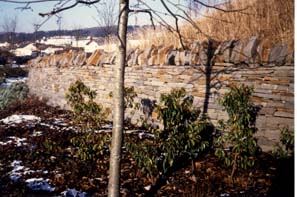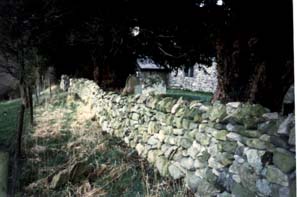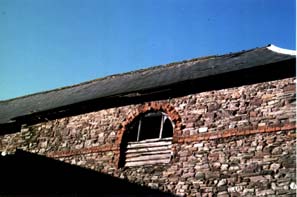

mr Philip Clark, Wales
THE IMPORTANCE OF STONE TYPE IN DRY STONE CONSTRUCTIONS
Introduction:
I bring greetings to you here in Slovenia from another small country, about the same size, the principality of Wales, a part of the United Kingdom which has now been partially self-governing for a whole six months. In its ancient Celtic vernacular language, I say;
Croeso o Gymru, a dymuniadau gorau ar y gynhadledd hon.
Greetings from Wales, and best wishes for this conference which is looking at the future of vernacular architecture. I am speaking as the International Coordinator of the Dry Stone Walling Association, not just of Wales but of Great Britain, a body which is dedicated to enabling one humble form of vernacular architecture survive and find new means of expression. People often think that this ancient craft has reached the end of its life, to use the phrase which Dr Juvanek has used in elation to vernacular architecture in general. It is a common experience, say at a demonstration at an agricultural show, for an onlooker to say, with satisfaction, "Ah, that's a dying art!"
This is not true; and we hope that dry stone walling is not even an example of Dr Juvanek's other phrase, a living museum. On the whole, dry stone work in Britain today is still abour building functional structures, and not functionless replicas of ancient building. The authenticity is shown in the craftsmanship and in the importance we attach to the materials we use, and in particular to the stone type; so I turn first to geology.
GEOLOGY
Much vernacular architecture is built of stone, an obvious building material in areas where rocks outcrop or are easily quarried, or have been carried and deposited by glaciers. Much of Europe comes under this description, and so the nature of the stone available is going to be very relevant to the style of vernacular architecture. This nature is going to depend on the underlying geology, and European geology is very varied, from the huge areas of metamorphic and plutonic rocks in Scandinavia to the Cretaceous limestones of the Mediterranean; from the recent volcanics of the Auvergne to the molasse deposits from the eroding Alps.
The British Isles have not the complete variety of European geology. However, the 1000 km traverse from the extreme north-west of Scotland to the extreme south-east of England is as good an example of this geological variety as any other area of Europe of similar size can offer. It goes from nearly 3000 million year old metamorphosed rocks to Quaternary sediments including every period in between. And vernacular architecture varies accordingly.
Architectural historians have not always appreciated the need to distinguish between stone types. One of the great merits of the late Nicholas Pevser's great Penguin series, The Buildings of England, [*SLIDE 1] was that it did this. Each volume covers one of the old counties, more or less, and has a section on the building stones of that area, distinguishing important geological measures and sometimes even beds. It is true that even with Pevsner the particular stone of a building described in the text is not usually specified. But whether vernacular or evolved architecture, the stone type is of great importance for the "feel" of the building.
Indeed, the principle applies to the areas where stone is not the natural building type. I lived for some years in the Weald, a wooded, clayey area south of London. There were still many farm buildings and cottages distinguished by oak beams and tile hanging, [*SLIDE 2] as well as by the Cretaceous sandstone and ironstone never far away. Move slightly further south or north and I was on the chalk where I was brought up, where one of the most distinct building materials is flint, [*SLIDE 3] sometimes together with clunch, the harder chalk.
I went to university only a little to the north-west again, but there round Oxford were still so many buildings in the various honey coloured Jurassic limestones - medieval churches, houses of all periods, and even some of the older university buildings themselves.
Much later I moved to Wales, and took up the building of dry stone walls as a trade. [*SLIDE 4 - ORS] It very soon became clear to me that the style of these humble field boundaries, as well as that of buildings on old farms, whether dry stone or mortared, varies according to local stone available.
The three towns nearest to me, Brecon, Builth Wells, and Hay-on-Wye, are all built predominantly of one stone type, and each of a different type. It is that more than anything else that gives them their individuality, and makes them collectively examples of "vernacular" architecture.
If I drive south from my home towards the Welsh capital, Cardiff, I am very conscious of passing from an area of buildings in Devonian Old Red Sandstone, [*SLIDE 5 - Brecon] through a narrow belt with field walls of big chunky Carboniferous limestone, [SLIDE 6] and then across the South Wales coalfield. Here the terraces of houses built on the hillsides or crowded on the narrow valley floors for the miners and ironworkers are not, as you would find in much of England, built of brick, with stone dressings for the more superior. [*SLIDE 7] They are built of the fine - and abundant - Pennant sandstone that caps the coalfield - with brick, the rarer material, for the dressings.
Similarly, if I drive north to where my son lives looking across the Menai Straits to Anglesey, I know when I am out of Mid-Wales and into North Wales because the building stone for barns or inns becomes more massive and darker. There are utterly distinct roadside walls where I cross the area round Blaenau Ffestiniog where most of the roofing slates for 19th century Britain came from. [*SLIDE 8]. Occasionally the slate is used in strange ways as a boundary.
In the north, I notice walls, free-standing or in buildings, where large chunks of igneous rock, often rounded by mountain torrents, have been levelled up with flat slatey stones. I remind myself I have seen the same in other igneous areas - in the Lake District of north-west England [*SLIDE 9] - and also in the Auvergne in Central France.
I have moved onto the subject of dry stone wall types as influenced by geology. Now, only certain parts of Britain have dry stone walls - [*SLIDE 10- MAP] rocks younger than Jurassic are too soft on the whole, and so dry stone walls are not found in south-east England. Elsewhere, they are chiefly in the more upland areas, and most noticeably in the Jurassic limestone belt which divides England diagonally from north-east to south-west, and in the areas where the older rocks which underlie northern England, Wales and Scotland, are readily available in hillier localities.
Dry Stone Walling
For dry stone purposes, rocks divide into stones that can be coursed (usually sedimentary, but also slates), those that demand random construction (most igneous and metamorphic rock), and those that permit roughly coursed work ("random coursing").
The most regular coursed walls [*SLIDE 11] are those with Coal Measures sandstones, especially those in parts of the north of England and in Scotland, and some of the limestone walls in the Cotswolds. Sedimentary rocks that can be easily split along bedding planes help in making a well-coursed wall.
Random walls [*SLIDE 12] are sometimes ones where fieldstones only are used (which in many areas include glacial erratics - a large part of Britain has had glacial cover repeatedly during the Quaternary) If local quarries are available, walls are often more regular. Many fieldstones present problems because they are either water-worn in streams or smoothed in glaciers, and so are rounded; dry stone walls need stones to go into the wall for strength.
Of course some rounded stones are very large, such as granites in the south-west of England and in many parts of Scotland; such areas with large boulders often have "single walls" [*SLIDE 13], with most stones running across the wall. Most other areas have "doubled walls", with the two sides built up separately but in conjunction. [*SLIDE 14]
Availability of large stones for foundations and long stones for throughstones is important. If these are lacking, as for example in parts of the South Wales coalfield or the Cotswolds, the walls tend to be narrower for their height, with less "batter", slope of the walls inwards as they go up.
Conversely, in many parts of the Pennine Hills in the north of England long stones are very abundant in the Carboniferous outcrops, especially in the Millstone Grit. So you will find continuous courses of through stones, projecting slightly on either side [*SLIDE 15] to allow for the wall settling and widening - and to show the farmer that they have been indeed used by the builder. Not infrequently there are two courses of throughstones. Elsewhere you may be lucky to have one every metre.
British dry stone walls are usually "coped", [SLIDE 16] finished off on the top for greater stability and to deter stock from crossing. Types of coping for walls vary with geology; a soft rock like the Permian New Red Sandstone can be carved into regular shapes, whereas in most parts of Britain upright (or sloping) copes [*SLIDE 17] are fairly irregular.
Areas with stone that naturally comes in big flags have flat tops, or copes placed on top of a projecting flat layer ("coverbands"). In the Cotswolds a rather unsightly mortar capping is often used [*SLIDE 18], because of the Jurassic limestone does not produce large pieces of rock, and any reasonably big ones have been used lower in the wall, for strength.
Where limestone outcrops, or is not too far away, lime mortar was often used in place of true dry construction. Walls for gardens, or for churchyards, often had it. The methods of preparing it were forgotten in recent years, but have been now recovered. It's not likely ever to be used again on the same scale as in the 18th or early 19th centuries. These walls can usually be satisfactorily repaired using just dry stone techniques.
What is not at all acceptable is to attempt to repair a dry stone wall by pointing from outside with some cement or mortar. [*SLIDE 19] It looks ugly, and never succeeds in holding the stones together for very long. Methods of construction of wet and dry stone walls are too different. Many dry walls have been built by wallers used to working with mortar, and they try to use stones as one can (but not desirably) with mortar. A stone turned on its edge and placed in a dry wall with little depth will not remain in place long. Moreover, if it is a flat sedimentary stone it will probably start laminating away.
A problem in repairing old dry stone walls is that in some areas there are few quarries of that rock. [*SLIDE 20] Old ones are often no longer used. In South Wales, for example, most of the quarries for building stone are in the Pennant gritstone, in the Upper Westphalian of the Carboniferous. There have been few quarries working for building stone in the limestone lower down, or in the Devonian Old Red Sandstone under that. Hence the Pennant has been appearing too far north of its range, where it looks unnatural in vernacular buildings.
I did, I must confess, notice the reverse the other day in Merthyr Tydfil. A dry stone wall was erected some years ago by the local authority in a deliberate attempt to reintroduce vernacular building into an urban improvement scheme [*SLIDE 21]. It was originally built of Pennant stone, which looked very much in place. When an addition was made recently red sandstone was brought over the mountains because it was cheaper. The particular beds are superficially similar, but to anyone with a knowledge of geology the mixture looks odd. I did use that Old Red Sandstone quarry myself to build a wall behind my own and my neighbours' gardens, [*SLIDE 22] whereas the rock outcropping on the hill above is Ludlow Beds shale of the Upper Silurian, the next oldest rock. [*SLIDE 23] But that shale is of poor quality, easily laminating or cracking and splitting once exposed to the air. It would have been wasted effort to try to use an unsatisfactory stone.
On the other hand, in repairing a nearby churchyard wall [SLIDE 24] built of Silurian shale, I scoured the parish (not very successfully) for any spare stone of the right beds and suitably tough. A farm in that area has more recently excavated some good Silurian gritstone; where that has been used on new mortared garden walls it already looks quite "vernacular".
Conclusion
I have been talking rather narrowly about "making the heritage of our ancestors usable", in Dr Juvanek's phrase, by concentrating on the correct materials both in restoration and in new works which focus on the aesthetic possibilities and not just on the practical nature of what started and has largely continued as a solution to practical landholding problems. But there are many other problems for the heritage of dry stone work tomorrow.[SLIDE 25]
This wall was recently rebuilt by the National Trust, Britain's and perhaps the world's premier conservation body, and the one that trained me to do this craft. It was necessary to put this wall in good order because it divides two vast systems of sheep grazing, each many thousands of hectares and comprising many different farms. It also has great cultural and aesthetic value. But as a section of about a kilometre of a wall that is continuous round these mountain tops in North Wales for about 20 kilometres, it clearly poses what Dr Juvanek calls a great burden. There are thousands and thousands of kilometres of derelict dry stone walls in Britain, and farm incomes, especially on hill farms, are at an all time low.
Most professional wallers in Britain today are actually making most of their income from new works with no agricultural reference - garden walls or such big eye-catching projects for local and national authorities as I showed earlier. They often employ modern techniques in the bigger projects - use of machines to move earth or place bigger stones; subtle use of hidden mortar; dry stone cladding to a blockwork building.
Such developments are inevitable. I am glad that our association works hard to uphold standards of workmanship, which includes an awareness of the correct use of the materials involved. I hope that I have at least shown something of the variety of these materials.

Recent new wall for lord authority at Merthyr Tydfil, South Wales

Newgarden wall, Llaneglwys, Breconshire

Recently rebuilt churchyard wall, Cefnllys, Radnorshire, Wales

Old Red Sandstone building in Brecon, Wales



